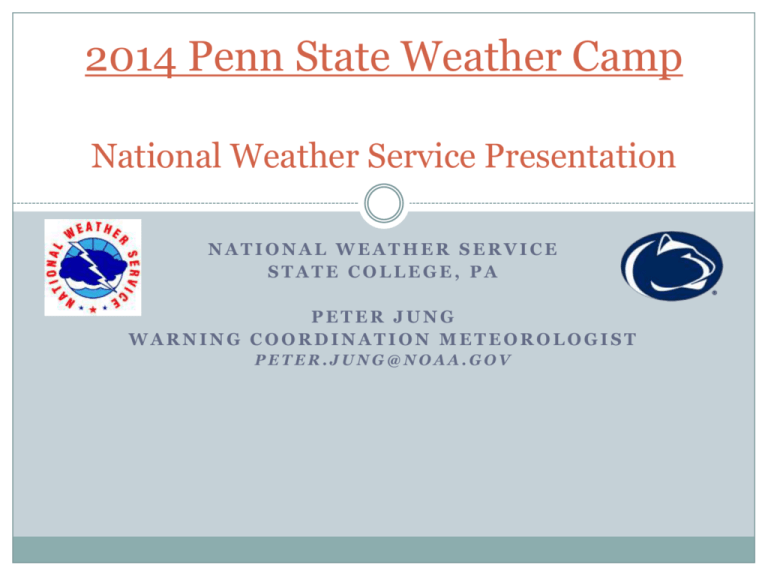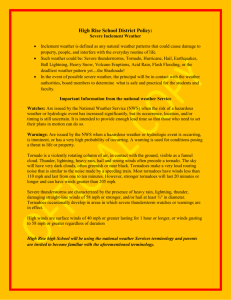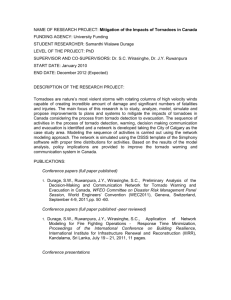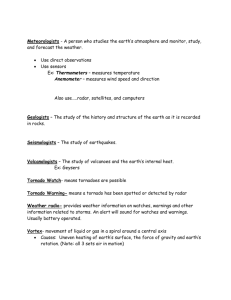Skywarn - Penn State Meteo Computing System Home Page
advertisement

2014 Penn State Weather Camp National Weather Service Presentation NATIONAL WEATHER SERVICE STATE COLLEGE, PA PETER JUNG WARNING COORDINATION METEOROLOGIST PETER.JUNG@NOAA.GOV A little bit about the National Weather Service National Weather Service Our parent agency is NOAA National Oceanic and Atmospheric Administration NWS (and NOAA) fall under the Department of Commerce Federal agency Tax-payer supported Does Weather have an Impact? Weather related damages exceed $20 billion per year 70% of all travel delays weather related Economic impact (direct impacts, delays, loss of work, etc.) on the U.S. over $3 trillion per year 97+% of all Presidentially declared disasters are weather related “Super” snowstorms, Hurricanes (Lee, Irene, Sandy, etc.), Severe thunderstorms and Tornadoes, Flash flooding. The Mission of the National Weather Service Primary Mission: Provide Weather, Hydrologic and Climate Forecasts and Warnings for the Protection of Life and Property Secondary Mission Objectives: Enhance the National Economy Provide a National Information Database which can be used by other government agencies, the private sector, and the Global Community Who is the National Weather Service Organization Local Offices 123 Local Weather Forecast Offices Five offices serve Pennsylvania 13 River Forecast Centers Two serve Pennsylvania AWC – Aviation Weather Center CPC – Climate Prediction Center EMC – Environmental Modeling Center NCO – NCEP Central Operations NHC – National Hurricane Center OPC – Ocean Prediction Center SPC – Storm Prediction Center SWPC – Space Weather Prediction Center WPC – Weather Prediction Center 6 Regional Offices 9 National Centers (NCEP) Eastern, Central Southern, Western, Alaska and Pacific NWS Headquarters Silver Spring, MD Where are all those Local Offices? Pennsylvania Counties and Corresponding National Weather Service Offices YOU ARE HERE A look at the local office Staffing: ~25 persons 10 full-time forecasters 3 interns 5 technicians 5 specialists in science, outreach, observing program and hydrology Open 24x7x365 Key Pieces of Equipment Satellite Remote Sensing Equipment Doppler Radar Powerful Computers SkyWarn Spotter Program In addition to all our remote sensing equipment, we use a VOLUNTEER group of TRAINED public citizens that observe and report weather to the NWS to: Supplement remote sensing equipment Provide real-time ground truth reports Add credibility to NWS products and services The SkyWarn program is NOT a storm-chasing network! SkyWarn Spotters act as thousands of “eyes and ears” out in the field, supporting our forecast and warning program! NWS Products: A Three–Tiered Approach Outlooks Time To Watches Event Warnings/ Advisories Confidence in the forecast Weather Definitions and Terms OUTLOOK A long term product (generally 3 to 7 days) Heads-up of something potential on the horizon Our confidence level is about % WATCH Conditions are FAVORABLE for a given weather event to occur, but not imminent Generally 6 hours to as much as 2 days Severe Thunderstorm, Tornado, Flood, High Wind, Snow, etc. Our confidence level is at about % Weather Definitions and Terms OUTLOOK A long term product (generally 3 to 7 days) Heads-up of something potential on the horizon Our confidence level is about 30% WATCH Conditions are FAVORABLE for a given weather event to occur, but not imminent Generally 6 hours to as much as 2 days Severe Thunderstorm, Tornado, Flood, High Wind, Snow, etc. Our confidence level is at about % Weather Definitions and Terms OUTLOOK A long term product (generally 3 to 7 days) Heads-up of something potential on the horizon Our confidence level is about 30% WATCH Conditions are FAVORABLE for a given weather event to occur, but not imminent Generally 6 hours to as much as 2 days Severe Thunderstorm, Tornado, Flood, High Wind, Snow, etc. Our confidence level is at about 50% Weather Definitions and Terms ADVISORY A shorter term product, mainly 0 – 24 hours High confidence that a weather event will occur, but with limited impacts Lighter snow and ice events, strong (but not severe) wind events, etc. Our confidence level is about % WARNING A shorter term product, mainly 0 to 24 hours High confidence that a significant, high impact, and potentially life threatening condition will take place Severe Thunderstorms, Tornadoes, Flash Floods, Heavy Snow/Ice, etc. Our confidence level is at about % Weather Definitions and Terms ADVISORY A shorter term product, mainly 0 – 24 hours High confidence that a weather event will occur, but with limited impacts Lighter snow and ice events, strong (but not severe) wind events, etc. Our confidence level is about 80% WARNING A shorter term product, mainly 0 to 24 hours High confidence that a significant, high impact, and potentially life threatening condition will take place Severe Thunderstorms, Tornadoes, Flash Floods, Heavy Snow/Ice, etc. Our confidence level is at about 80% Thunderstorms REVIEW OF A LIFECYCLE OF A THUNDERSTORM Lifecycle of a Thunderstorm Developing Stage Dominated by UPWARD MOVING air Extends vertically to 10,000 to 20,000 ft No Severe Weather at this stage Depending on atmospheric conditions, this may (or may not) develop into a thunderstorm Lifecycle of a Thunderstorm Mature Stage Storm contains UPWARD and DOWNWARD moving air Extends vertically to 40,000 to 60,000 ft Best potential for severe weather including hail at this stage With rotation, this can lead to a tornado Lifecycle of a Thunderstorm Dissipating Stage Storm contains mostly DOWNWARD moving air Supply of warm moist air “fuel” has been exhausted or cut off Transition from “mature” to “dissipating stages best time for Downbursts to occur Types of Thunderstorms QUIZ Pulse Type Characteristics: Average Lifespan:? 30-60 minutes 1 to 3 hours 3 to 6 hours > 6 hours Severe Potential? Low Moderate High Most significant threat? High winds Tornadoes Hail Flooding Wind Shear Environment? Weak Strong QUIZ Pulse Type Characteristics: Average Lifespan:? 30 -60 minutes 1 to 3 hours 3 to 6 hours > 6 hours Severe Potential? Low Moderate High Most significant threat? High winds Tornadoes Hail Flooding Wind Shear Environment? Weak Strong QUIZ Pulse Type Characteristics: Average Lifespan:? 30 -60 minutes 1 to 3 hours 3 to 6 hours > 6 hours Severe Potential? Low Moderate High Most significant threat? High winds Tornadoes Hail Flooding Wind Shear Environment? Weak Strong QUIZ Pulse Type Characteristics: Average Lifespan:? 30 -60 minutes 1 to 3 hours 3 to 6 hours > 6 hours Severe Potential? Low Moderate High Most significant threat? High winds Tornadoes Hail Flooding Wind Shear Environment? Weak Strong QUIZ Pulse Type Characteristics: Average Lifespan:? 30 -60 minutes 1 to 3 hours 3 to 6 hours > 6 hours Severe Potential? Low Moderate High Most significant threat? High winds Tornadoes Hail Flooding Wind Shear Environment? Weak Strong Types of Thunderstorms Back-Building Storms Characteristics: Multiple Cells...where each cell generates a cold outflow that triggers a gust front Severe potential is higher than pulse storms Good potential Flash Flood producers Cells may propagate (new cells form) different direction from the movement of overall storm system “Training Echoes” Johnstown Flood Johnstown Area – Prone to Devastating Flash Floods May 1889 – March 1936 – July 1977 May 31, 1889 – 2209 fatalities March 17, 1936 “St. Patrick’s Day Flood” - 25 deaths - 9000 homeless - $50 million in damages - Heavy rain and snowmelt - Water 14 feet deep in downtown Johnstown July 19-20, 1977 -Over 12 inches of rain from training MCS, eventual failure of the Laurel Run Dam and seven others! - 78 lives lost - 50,000 homeless - $200 million in damages QUIZ Multicell Line or Squall Line Type Characteristics: Multicell Thunderstorm complex in a line Severe potential is higher than pulse storms Best Severe Potential is: • • • • Strong Wind Hail Tornadoes Flooding QUIZ Multicell Line or Squall Line Type Characteristics: Multicell Thunderstorm complex in a line Severe potential is higher than pulse storms Best Severe Potential is: • • • • Strong Wind Hail Tornadoes Flooding QUIZ Supercell Type Characteristics: Average Lifespan:? 30-60 minutes 1 to 3 hours 3 to 6 hours > 6 hours Severe Potential? Low Moderate High Most significant threat? High winds Tornadoes Hail Flooding Wind Shear Environment? Weak Strong QUIZ Supercell Type Characteristics: Average Lifespan:? 30-60 minutes 1 to 3 hours 3 to 6 hours > 6 hours Severe Potential? Low Moderate High Most significant threat? High winds Tornadoes Hail Flooding Wind Shear Environment? Weak Strong QUIZ Supercell Type Characteristics: Average Lifespan:? 30-60 minutes 1 to 3 hours 3 to 6 hours > 6 hours Severe Potential? Low Moderate High Most significant threat? High winds Tornadoes Hail Flooding Wind Shear Environment? Weak Strong QUIZ Supercell Type Characteristics: Average Lifespan:? 30-60 minutes 1 to 3 hours 3 to 6 hours > 6 hours Severe Potential? Low Moderate High Most significant threat? High winds (Downburst) Tornadoes Hail Flooding Wind Shear Environment? Weak Strong QUIZ Supercell Type Characteristics: Average Lifespan:? 30-60 minutes 1 to 3 hours 3 to 6 hours > 6 hours Severe Potential? Low Moderate High Most significant threat? High winds (Downburst) Tornadoes Hail Flooding Wind Shear Environment? Weak Strong Severe Thunderstorms and Damage STRAIGHT LINE WINDS DOWNBURSTS MICROBURSTS MACROBURSTS TORNADO DERECHO Severe Thunderstorms Definition: ?? mph, A thunderstorm producing Winds in excess of 58 structural damage, or large hail greater than ?? 1 inch in diameter Lightning, no matter how frequent or deadly is NOT a measure of a Severe Thunderstorm Straight Line Winds Probably the most common wind damage type in Pennsylvania Often the result of a Squall Line Result from a combination of the forward movement of the storm, and transport of high winds aloft down to the surface. Straight line winds may occur ahead of the actual “storm” at the leading edge (or gust front) Straight Line Winds 35 mph winds at 5000 feet + Cold Front moving at 30 mph = Surface wind gusts of 65 mph Straight Line Winds Straight Line Winds As the name implies...damaging winds produce damage in a unidirectional pattern Not as glamorous as a tornado in name...but can be far more destructive Often covers a large geographic area with many damage reports Straight Line Winds Straight Line Winds Do not be fooled by the extent or intensity of damage, or by the structures the wind affects. Roofs blown off barns/houses, uprooted trees, and even twisted trees are not necessarily an indicator of a tornado Straight Line Winds can easily exceed 100 mph! Straight Line Winds Radar Loop Straight Line Winds STRAIGHT LINE WINDS Damage shows a clear UNI-DIRECTIONAL pattern STRAIGHT LINE WIND “fingerprint” Downburst Winds The second most common damaging winds in Pennsylvania Unlike straight-line-winds, Downbursts are formed by the outrush of air from aloft brought down by the thunderstorm Damage can be more concentrated than Straight Line Winds Winds can exceed 150 mph...That’s the equivalent of an EF3 Tornado! Downburst Downbursts can be as destructive IF NOT MORE destructive than tornadoes Often cover much larger areas than a tornado Are much more common than tornadoes Downbursts, by their nature, are winds diverging on the ground While trees and damage may be oriented in different directions, they show a pattern of emerging outward from a central point These can cause significant tree and structural damage. More often than not, a very large damage path is indicative of a Downburst rather than a Tornado Downburst Damage to NWS Radar We are not Immune! Built to withstand 134 mph winds Downburst / Microburst / Macroburst Downburst: Generic term for downward moving air that spreads out when it reaches the ground Microburst Term for a Downburst less than 2.5 miles in extent Macroburst Term for a Downburst grater than 2.5 miles in extent These terms all describe the same mechanism, and only are differentiated by the size and scope of the damage DOWNBURST Central PA Downburst Wind Event (04/19/13) Dauphin County Doppler Reflectivity (around 6:20 pm EDT) showing a fairly straight line of storms. Central PA Downburst Wind Event (04/19/13) Dauphin County Doppler Reflectivity (around 6:37 pm EDT) showing a “bowing out” segment of the line of storms, a good indicator of accelerating winds and a fingerprint of a Downburst wind event. Downburst Radar Loop DOWNBURST Damage shows a clear DIVERGING pattern DOWNBURST “fingerprint” Tornado Very specialized wind event It takes unique conditions aloft in the storm, and very close to the ground, to produce a Tornado 1 in 100 thunderstorms are severe, and on average 1 in 100 “severe” thunderstorms produce Tornadoes Pennsylvania sees about 15 tornadoes per year. Tornadoes usually produce a very small and defined area of damage (path) THE DEGREE OF DAMAGE DOES NOT INDICATE WHETHER OR NOT THERE WAS A TORNADO! Tornadoes A look at a Tornado on Doppler Radar Tornado Winds Much different than Straight Line and Downburst Winds Pattern of Damage shows CONVERGENCE...winds being pulled into the center of the tornado Tornado Is it always that easy? NO! A key is to see where the rotation is, and what is it doing with time! Lots of storms show mid and upper level rotation Tornado Another KEY question: Is the atmosphere near the ground primed for tornadoes? Right conditions of moisture and shear need to be present! Tornadoes – Some Terms Wall Cloud – Rotating lowering (and often rain- free) section of a thunderstorm. ROTATION IS THE KEY!!!! Sign that conditions within the storm are right for producing a tornado But what are the low level conditions below the storm??? A Wall Cloud, while looking impressive, is not causing damage! Funnel Cloud Funnel Cloud – Fast spinning funnel descending from the thunderstorm cloud...BUT NOT YET REACHING THE GROUND! ROTATION IS THE KEY!!!! Sign that conditions within the storm are right for producing a tornado Again, what about conditions below the storm? A Funnel Cloud, while looking very impressive, is NOT causing damage. It may become a tornado soon! Tornadoes – Tornado Tornado – Rapidly rotating funnel of air IN CONTACT WITH THE GROUND! ROTATION, STILL, IS THE KEY!!!! Look for Damage: No Damage = No Tornado! Campbelltown Tornado – July 14, 2004 Campbelltown Tornado (SRM) TORNADO Damage shows a clear CRISS-CROSS pattern TORNADO “fingerprint” TORNADO Damage shows a clear CONVERGENT pattern TORNADO “fingerprint” Damage shows a clear CYCLONIC turning TORNADO “fingerprint” TORNADO Enhanced Fujita Scale Used to Estimate Winds in a tornado Based on after-the-fact damage surveys Expected wind speeds based on engineering studies NOTE: The EF-Scale is a reworking of the F-Scale introduced decades ago Wind Speeds adjusted to reflect more accurate measurements EFScale EF0 EF1 EF2 EF3 EF4 EF5 Wind Speed 65-85 86-109 110-137 138-167 168-199 200-234 Be wary of Tornado “look-a-likes” Wall Clouds Make sure they are rotating and connected to the cloud base! Funnel Clouds Again, look for rotation...not just a cloud that looks like a funnel Tornado What damage is it producing Debris! Which way is it moving Pennsylvania Tornadoes through the Years COMMON TORNADO MYTHS Myth: Trees laying in different directions must mean tornado damage. • The direction trees are laying can be influenced by things like tree type, tree bark, size of tree, amount of foliage, wind load, root structure, and soil conditions. • Local terrain can influence the wind direction and change the way trees are blown down. • Branches or trunks can lay in different directions if there is tree rot causing weak or failure points. Myth: "Projectiles" automatically suggest a tornado. • While projectiles are common from a tornado, straight line wind (especially a downburst) can throw debris down wind and produce projectiles. Myth: A "roaring" sound suggests a tornado. • Witnesses often describe a "roaring" or freight train sound with a tornado but that sound can also occur from straight line winds as they pass through trees, forests, or terrain. Those who have been struck by a tornado also describe a high-pitch whine or squeal sound as it hits. Myth: Damage = Tornado! • Not all damage is tornado related. More times than not it is simply straight-line wind. • The severe thunderstorm that produces a tornado (usually a Supercell) often produces straight line wind damage as well. It is very common to have both types of damage related to the same parent thunderstorm in different areas. COMMON TORNADO MYTHS Myth: Uprooted trees are only caused by Severe Thunderstorms (gusts of 58 mph or higher). • Root structure can make a big difference. Shallow roots may allow the tree to topple much easier. • Soil type and moisture content can also allow a tree to uproot with winds well below 58 mph. • Tree rot can cause branches or entire trees to be toppled with relatively weak wind speeds. Myth: Structures explode in a tornado due to lower pressure. • Structures are torn apart in a tornado from the wind or from the impact of debris. Myth: Twisting automatically means a tornado hit. • Not true. Houses, for example, are usually impacted by wind in one primary direction due to the size of the tornado. You need to examine the entire area impacted. Another example is stop signs…you can see these “twist” in strong winds even without a tornado. Derecho Derecho Extreme Straight Line Wind (Bow Echo) that covers a huge area 250+ miles long Lasting at least 6 hours May 21, 2004 June 30, 2012 Derecho Another Look with Velocity Portable deck used for concerts was lifted and blown away at Hershey Park 06/29/2012 Straight Line (Derecho) Wind Damage near Hershey, PA – 06/29/2012 Straight Line (Derecho) Wind Damage near Hershey, PA – 06/29/2012 Hail The “idealized” Supercell Hail forms in the region BETWEEN the upward moving air and downward moving air Hail Storm – May 22, 2014 Hail Storm – May 22, 2014 Flooding RIVER FLOODS FLASH FLOODS River Flooding Forecasts handled by the River Forecast Center These are for specific, gauged locations along Main Stem Rivers and large tributaries Locations where it takes more than 6 hours for the waterway to respond to heavy rainfall Many streams and creeks are ungauged, and are covered by Flood and Flash Flood products River Forecasts are driven by.... Forecast Rainfall Soil conditions Snow Melt Temperatures Time of Year (foliage) Routing of upstream water Reservoir and Dam releases Flash Flooding Rapid Rises on small (ungauged) streams and creeks Mainly driven by... Slow moving, heavy rain producing thunderstorms Repeated rainfall over the same area Dam Breaks Ice Jams These streams and creeks respond in minutes to a few hours after a heavy rain event Major threat to LIFE and PROPERTY Flooding Fatalities Flooding Fatalities Flooding Fatalities Flooding Fatalities Is your bus driver crazy enough to do this? A last word about Safety SAFETY TORNADOES Never try and outrun a tornado Immediately get to a sturdy structure...if not...get out of your car! Do not take shelter under bridges or overpasses FLASH FLOODS Turn Around, Don’t Drown...Don’t drive through flooded roads As little as 18 inches of moving water can carry away most vehicles LIGHTNING Get in a hard-topped vehicle Don’t use a corded phone Don’t stand under a tall object SAFETY DOWNBURST and HIGH WINDS Keep a firm grip on the steering wheel to maintain control If it can be done safely...point your vehicle into the direction of the wind Be prepared for sudden visibility restrictions In a building, move away from windows HAIL Get in a strong building Hard topped vehicles provide good protection for hail about golf ball sized. Larger hail will damage windshields.





